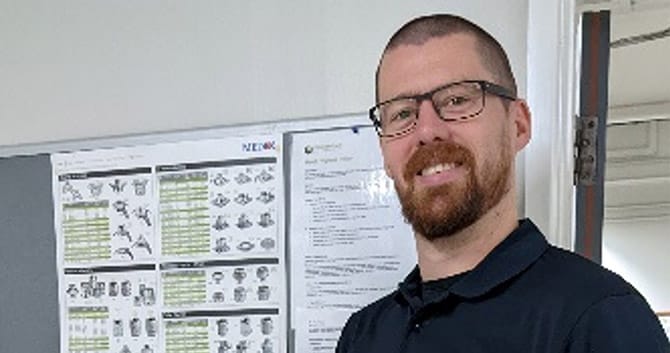Microprocessor Technology Explained
Posted on Thursday, February 29, 2024
Empowering Amputees: A Comprehensive Exploration of Microprocessor Technology with Blatchford Prosthetist David Logan.
 David Logan
David Logan
Prosthetist
Living with limb loss poses unique challenges, but advancements in prosthetic technology, particularly microprocessor knees, have significantly improved the lives of amputees. This article delves into the benefits, common misconceptions, and differences between microprocessor, hydraulic, and mechanical knees, providing valuable insights from David Logan, a highly experienced Blatchford Prosthetist based in Sheffield, UK.
The Blatchford Microprocessor Range:
David Logan enthusiastically shares, "In our range, we offer three incredible microprocessor products – the Orion3, Elan, and Linx. These microprocessor devices go beyond providing stability; they offer users newfound confidence and an enhanced quality of life in their daily activities."

Stability and Cognitive Load:
Dave highlights the transformative impact of microprocessor technology:
"One key aspect is the reduction of cognitive load. With microprocessor knees, users no longer need to constantly focus on maintaining stability. This increases satisfaction and significantly improves our patients' overall quality of life."
Personal Stories of Transformation:
Delving into the emotional impact of microprocessor technology, David shares poignant narratives that resonate deeply with users...
“I vividly remember one individual who used to sit in the car while his wife walked the dogs in the hills. Now, with a microprocessor knee, he joyfully walks alongside them. The heartfelt comments we often receive centre around newfound abilities – 'I can do more, and I don't have to think about it.'”
Expanding on the emotional connection, David recounts a particularly touching story, "There was another gentleman who, in his pre-microprocessor days, used to sit and listen to the radio. Now, he not only walks with his wife, but he also expresses the joy of simply being able to stroll together. The transformative power of microprocessor technology is evident in these personal stories of individuals reclaiming simple pleasures."
David highlights the impact on recreational activities: "In a more exhilarating instance, a gentleman who used to be part of a band revealed how he utilises the microprocessor knee. He can put his Orion3 into flexion lock mode, allowing him to strike dynamic poses on stage. This newfound flexibility and stability contribute to functional improvements and the artistic expression of individuals."
Perhaps one of the most heartwarming stories involves a father who refrained from carrying his daughter during her first year of life due to fear of falling. David recounts with emotion, "This individual, after getting the Orion3 microprocessor knee, experienced a transformative shift within a month or two. Now, he proudly walks around, carrying his daughter – a testament to the stability and confidence microprocessor technology provides, mending physical limitations and fostering meaningful connections within families."
Choosing the Right Device:
In discussing the crucial process of selecting the right microprocessor knee for an individual, David Logan delves into the considerations and factors involved. He emphasises, "Patient selection is critical to determining the most suitable microprocessor knee. We consider factors such as activity level and personal preferences, ensuring a tailored fit that aligns with each individual's lifestyle and aspirations."
However, David also highlights the importance of recognising the limitations of specific users. He elaborates on why some individuals might not be suitable for microprocessor knees, stating, "We have encountered cases where individuals have trialed microprocessor knees but were deemed unsuitable due to their high activity level. Some were turned away because their activity level exceeded what the knee could keep up with."
He further explains the inherent stability of microprocessor knees, pointing out a nuanced consideration for individuals with high activity levels, "Microprocessor knees are inherently stable, and as such, they are less suitable for high activity. Interestingly, the more unstable the knee is, the better it is for high-activity situations."
To clarify users in layman's terms, David employs a relatable analogy: "Talking in level terms or activity terms, to the layman, the Orion3, and microprocessors, in general, are suited for a K3 level. The Orion3, for example, is ideal for a normal adult engaged in regular activities like going for a hike in the peaks, a walk along the Thames, or even a stroll through the mountains. It's wonderful for those activities. However, I would advise against engaging in more strenuous activities like a park run."
By providing detailed insights and addressing potential limitations, David ensures that individuals seeking microprocessor knees understand this advanced prosthetic technology's benefits, realistic expectations, and considerations.
Ingress Protection (IP) Rating:
Addressing water exposure concerns, David Logan provides detailed insights to ensure patients comprehensively understand the IP rating associated with microprocessor knees. He explains, "The Ingress Protection (IP) rating is crucial when considering water exposure. For instance, other MPK’s (microprocessor knees) have an IP rating of 67, meaning the electronics are waterproof up to one meter, up to 30 minutes, and in freshwater."
The Orion3 microprocessor knee worn by Ben, is IP55 rated for water-resistance.
However, David clarifies the practical aspects of this rating, stating, "It's essential to note that this doesn't extend to environments like swimming pools, which are chlorinated, or showers with soapy water. The IP rating has not been tested against elements such as water jets. So, for our patients, a rating of IP55 may seem lower on the surface, but in reality, it is better and more appropriate for daily activities."
To illustrate this point further, David provides a relatable scenario, "For example, if you're washing your car and hitting it with the hose, or if you're washing it down and it gets muddy, an IP55-rated microprocessor knee can confidently withstand these activities without compromising its functionality."
By offering these detailed explanations and practical examples, Logan ensures that individuals considering microprocessor knees are well-informed about the devices' limitations and capabilities in various water-related scenarios.
Handling Major Faults:
Addressing potential faults, David explains, "In the rare event of a major fault, microprocessor knees are designed to enter a stiff mode, ensuring user safety while walking. This feature allows individuals to maintain mobility until the issue is addressed, providing a safety net during unforeseen circumstances."
Conclusion:
David Logan's detailed insights highlight how microprocessor technology has revolutionised the prosthetic industry, offering stability and a holistic improvement in the lives of amputees. By addressing patient concerns, debunking misconceptions, and understanding the diverse range of microprocessor knees available, individuals can make informed decisions to reclaim their active and fulfilling lives.
More articles
-

Ryan Drayton - Adaptive Riding
Posted on Thursday, April 11, 2024 , in Patient Newsletter: February 2024
-

Laura Ritchie - Understanding K-Level Classification in Prosthetics
Posted on Thursday, April 11, 2024 , in Patient Newsletter: February 2024
-

Dave Logan - Microprocessor Technology Explained
Posted on Thursday, April 11, 2024 , in Patient Newsletter: February 2024
